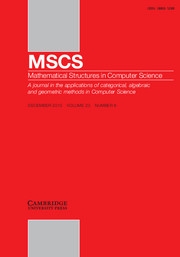Article contents
Unary automatic graphs: an algorithmic perspective
Published online by Cambridge University Press: 01 February 2009
Abstract
This paper studies infinite graphs produced from a natural unfolding operation applied to finite graphs. Graphs produced using such operations are of finite degree and automatic over the unary alphabet (that is, they can be described by finite automata over the unary alphabet). We investigate algorithmic properties of such unfolded graphs given their finite presentations. In particular, we ask whether a given node belongs to an infinite component, whether two given nodes in the graph are reachable from one another and whether the graph is connected. We give polynomial-time algorithms for each of these questions. For a fixed input graph, the algorithm for the first question is in constant time and the second question is decided using an automaton that recognises the reachability relation in a uniform way. Hence, we improve on previous work, in which non-elementary or non-uniform algorithms were found.
Information
- Type
- Paper
- Information
- Mathematical Structures in Computer Science , Volume 19 , Special Issue 1: Theory and Applications of Models of Computation (TAMC) , February 2009 , pp. 133 - 152
- Copyright
- Copyright © Cambridge University Press 2009
References
- 6
- Cited by

